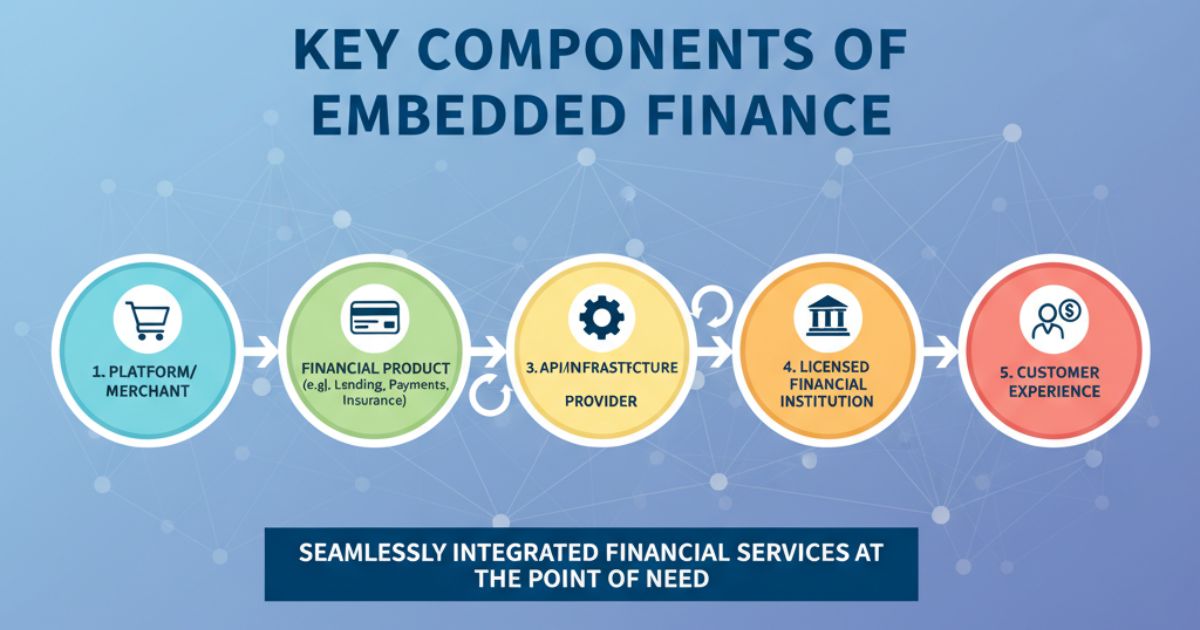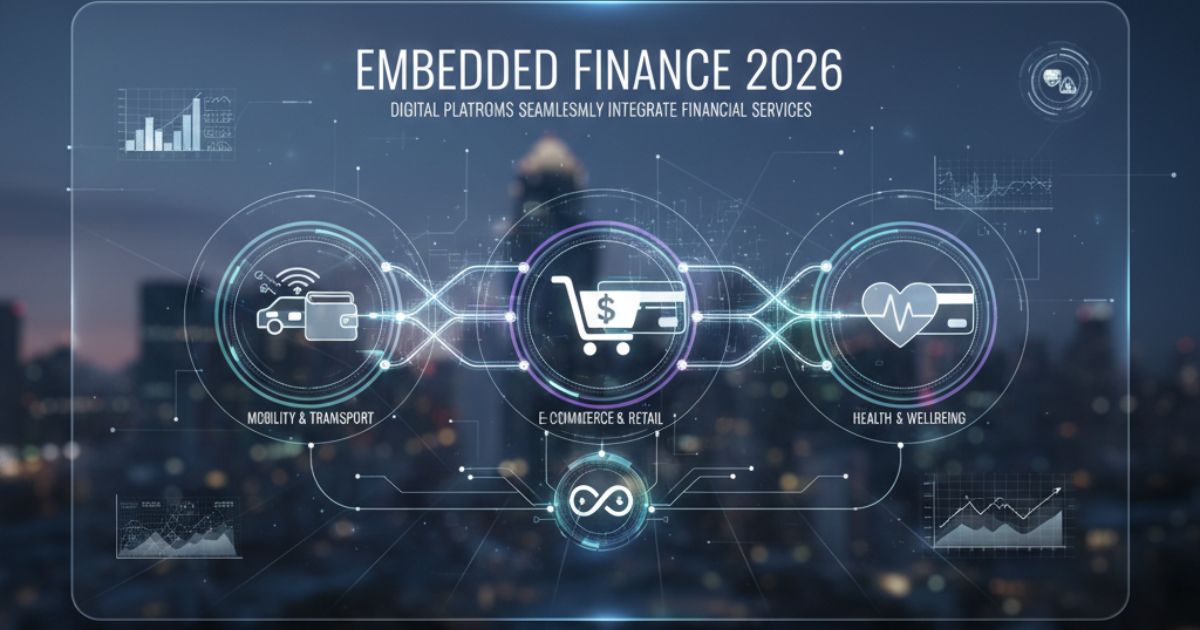Digital finance has evolved rapidly over the past decade, transforming how consumers access banking, payments, lending, and insurance. In 2026, one of the most significant developments in this space is embedded finance—a model that integrates financial services directly into non-financial digital platforms. According to industry analysts, the embedded finance market is projected to exceed $230 billion by the end of 2025. This growth is driven by consumer demand for convenience, personalization, and instant processing.
Stay with us as we delve into embedded finance, examining its definition, key components, benefits, real-world applications, compliance challenges, implementation best practices, and future trends. By the end, you’ll understand why embedded finance is reshaping the digital economy and how businesses can harness its potential.
What Is Embedded Finance?
Embedded finance refers to the seamless integration of financial services—such as payments, lending, insurance, and investment—within the user experience of non-financial applications and platforms. Unlike traditional banking, where customers must navigate separate portals or apps, embedded finance allows users to access financial products at the point of need without leaving their preferred digital environment. This model is powered by APIs (Application Programming Interfaces), which connect platform partners to banking and insurance systems, enabling real-time transactions, automated underwriting, and dynamic risk evaluation. From origin to maturity, the concept draws on open banking principles, API economies, and the rise of banking-as-a-service (BaaS) providers. As a result, companies can embed a variety of financial capabilities directly into their websites, mobile apps, or third-party ecosystems, delivering frictionless experiences that enhance customer engagement and revenue generation.
Key Components of Embedded Finance

- APIs and SDKs: Core to embedded finance, these software tools facilitate secure connections between platforms and financial institutions, enabling seamless integration. They enable developers to integrate services such as payment processing, account creation, and credit checks with minimal overhead.
- Banking-as-a-Service (BaaS) Providers: BaaS platforms serve as intermediaries, offering modular financial services through white-labeled APIs. They handle the heavy lifting—liquidity management, compliance, and core banking functions—allowing businesses to focus on delivering an exceptional customer experience.
- Data Analytics and AI: Advanced analytics tools and machine learning algorithms analyze transactional and behavioral data to deliver personalized offers, credit risk assessments, and real-time fraud detection. This intelligence is crucial for optimizing user journeys and minimizing operational risks.
- Regulatory Compliance Modules: Embedded finance solutions must adhere to local and international regulations, including PSD2, GDPR, KYC, AML, and PCI DSS. Compliance modules automate identity verification, transaction monitoring, and reporting to ensure alignment with legal and regulatory requirements.
- User Experience (UX) Layers: A seamless user interface is critical. Platforms often build custom UX components—such as forms, prompts, and dashboards—that integrate with backend financial APIs to deliver a cohesive experience without redirecting users to third-party sites.
Benefits for Businesses and Consumers
For businesses, embedded finance unlocks new revenue streams and monetization strategies. Companies can earn interchange fees on payments, interest spreads on embedded financing, and referral commissions for insurance offerings. Additionally, self-service financial tools increase customer retention by reducing friction and enhancing loyalty. On the operations side, automation reduces manual processing costs and accelerates time to market for new financial products.
Consumers enjoy the convenience of accessing financial services within apps and platforms they already use. Whether it’s a ride-hailing app offering in-app wallet top-ups, an eCommerce site providing point-of-sale financing, or a healthcare portal streamlining patient billing, embedded finance simplifies transactions and saves time. Moreover, personalized credit and insurance products tailored to individual needs promote better financial health and inclusion, particularly in underserved segments that lack access to traditional banking services.
Use Cases Across Industries
- eCommerce and Retail: Customers can check out with one-click payments, apply for buy-now-pay-later financing, or access tailored cashback offers without leaving the merchant’s website.
- Mobility and Ride-sharing: In-app wallets allow users to pay for rides, top up balances, and tip drivers seamlessly, while platforms can offer driver loans and insurance products.
- SaaS and Marketplaces: B2B software solutions embed invoicing, transaction processing, and embedded lending to optimize cash flow and subscription management for their users.
- Healthcare and Wellness: Patient portals integrate billing, insurance claims submissions, and financing plans for elective procedures, improving transparency and reducing administrative overhead.
- Travel and Hospitality: Booking platforms integrate currency exchange, travel insurance, and dynamic credit offers, providing a seamless booking-to-payment experience.
Regulatory and Security Considerations
Embedded finance sits at the intersection of technology and regulation. Companies must navigate a complex landscape of financial regulations, including PSD2 in Europe, Open Banking rules in the UK, GDPR for data privacy, and AML/KYC requirements globally. Engaging with licensed BaaS providers can mitigate regulatory risk, as these partners often maintain the necessary banking licenses and compliance infrastructure. Security is equally critical: organizations must implement end-to-end encryption, tokenization of sensitive data, multi-factor authentication, and continuous fraud monitoring. Regular security audits and compliance assessments ensure that embedded finance integrations remain robust and trustworthy.
Implementation Best Practices
Launching an embedded finance initiative requires a cross-functional approach. Start by defining clear business objectives—whether it’s boosting average order value, improving customer retention, or generating financial revenue. Next, select technology partners with proven track records, robust APIs, and transparent pricing models. Early-stage proofs of concept (POCs) in sandbox environments allow teams to validate user flows, performance, and security before scaling. Integrate compliance checks and risk controls from day one, leveraging third-party compliance modules or consulting with regulatory experts. Finally, invest in user experience design and customer support to handle inquiries, troubleshoot issues, and gather feedback for iterative improvements.
Future Trends in Embedded Finance

The embedded finance landscape is expected to continue maturing through 2026 and beyond. Key trends to watch include greater use of AI-driven personalization, which will enable hyper-tailored financial recommendations and dynamic pricing. Blockchain and decentralized finance (DeFi) protocols may introduce new models for cross-border payments and settlement, reducing costs and settlement times. Expect the rise of “Composable Banking” architectures, where modular microservices allow companies to pick and choose granular financial functions. Sustainability-focused financial products—such as embedded carbon offset payments—will also gain traction as consumers and regulators prioritize environmental impact. Ultimately, partnerships between traditional banks and digital-native platforms will intensify, fostering hybrid ecosystems that strike a balance between stability and innovation.
Conclusion
Embedded finance represents a paradigm shift in how financial services are consumed and delivered. By integrating payments, lending, and insurance into everyday digital experiences, businesses can unlock new revenue streams, streamline operations, and differentiate their offerings. Consumers benefit from faster, more personalized, and inclusive financial solutions—all within the familiar interfaces they use daily. As regulatory frameworks evolve and technology advances, embedded finance will become increasingly ubiquitous across industries, ushering in a new era of digital finance that prioritizes fluidity, customization, and accessibility. Companies that embrace this trend today will be at the forefront of the next wave of financial innovation.








Understanding Digital Financial Innovation and Its Impact
Revolutionizing Customer Onboarding: The Power of Digital Identity Verification in Digital Finance
Cybersecurity in Digital Finance: A Guide to Asset Protection
The Rise of RegTech: FinTech Compliance Tools You Need to Know
Digital Identity Verification in Finance: Enhancing Security and Compliance
Revolutionizing Customer Onboarding: The Power of Digital Identity Verification in Digital Finance
Embedded Finance in 2026: How Digital Platforms Seamlessly Integrate Financial Services
How Fintech Is Revolutionizing Small Business Financing